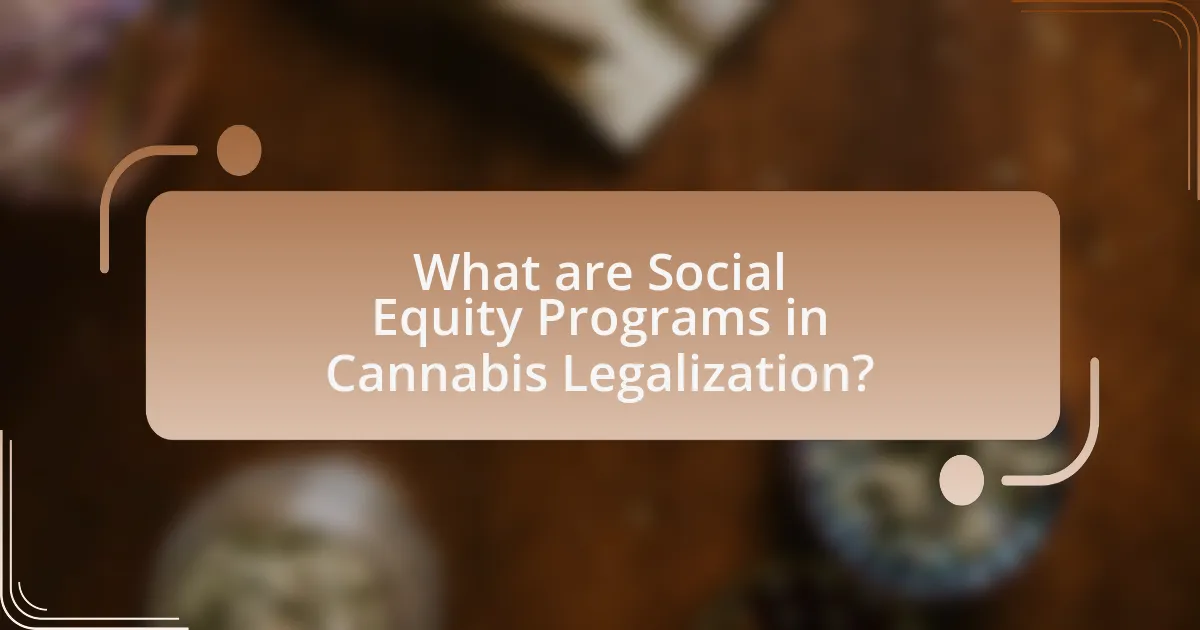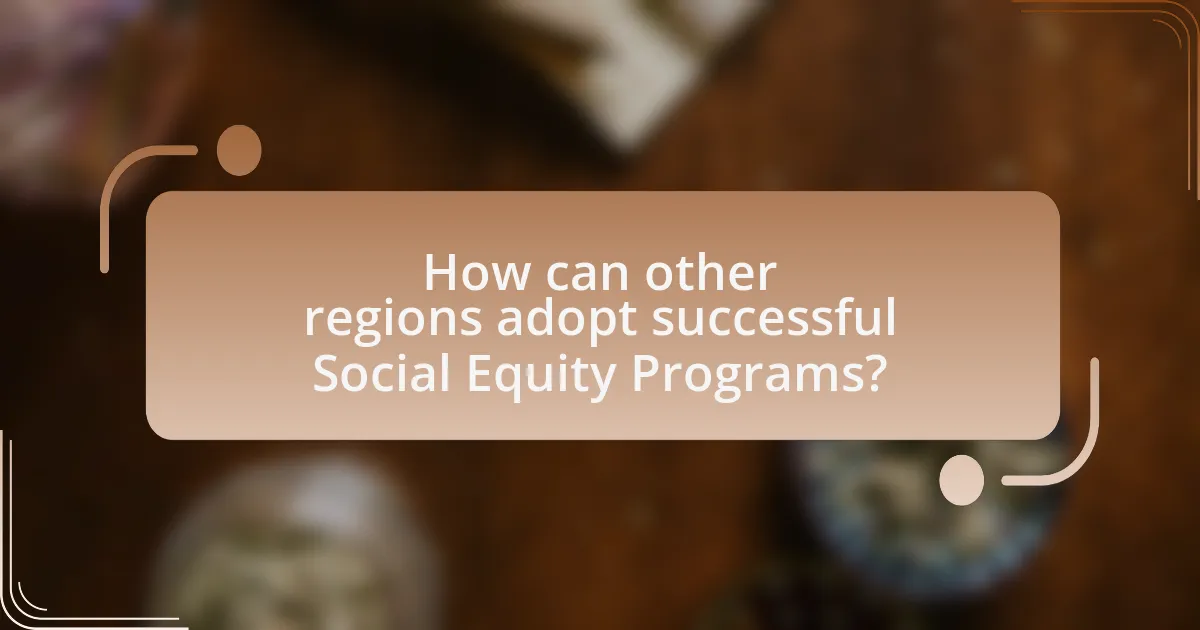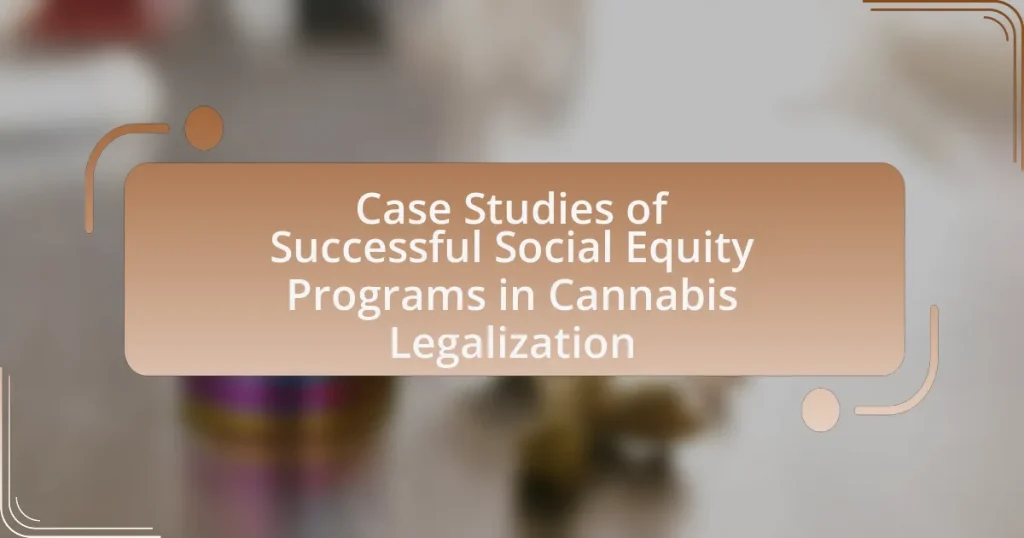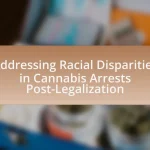Social Equity Programs in cannabis legalization are initiatives aimed at addressing historical injustices faced by communities disproportionately affected by cannabis prohibition. This article examines successful case studies from states like California, Illinois, and Massachusetts, highlighting key components such as financial assistance, training, and community engagement that contribute to their effectiveness. It also discusses the specific injustices these programs target, the metrics used to evaluate their success, and the challenges encountered during implementation. By analyzing these programs, the article provides insights into best practices and strategies for fostering inclusivity and economic empowerment within the cannabis industry.

What are Social Equity Programs in Cannabis Legalization?
Social Equity Programs in cannabis legalization are initiatives designed to address the historical injustices and disparities faced by communities disproportionately affected by cannabis prohibition. These programs aim to provide opportunities for individuals from these communities to participate in the legal cannabis industry through measures such as financial assistance, training, and licensing support. For example, states like California and Illinois have implemented social equity provisions that prioritize applicants from neighborhoods with high rates of cannabis-related arrests, thereby promoting inclusivity and economic empowerment in the emerging cannabis market.
How do Social Equity Programs aim to address historical injustices?
Social Equity Programs aim to address historical injustices by providing targeted support and resources to communities disproportionately affected by past drug policies, particularly in cannabis legalization. These programs often include measures such as financial assistance, access to business licenses, and training opportunities specifically designed for individuals from marginalized backgrounds. For instance, in states like California, social equity initiatives have been implemented to rectify the economic disparities created by the War on Drugs, which historically targeted minority communities. Data shows that these programs can lead to increased ownership and participation in the cannabis industry among those who have faced systemic barriers, thereby promoting economic empowerment and social justice.
What specific injustices are these programs targeting?
These programs are targeting specific injustices related to the disproportionate impact of cannabis prohibition on marginalized communities, particularly communities of color. Historical data shows that Black and Latino individuals are arrested for cannabis-related offenses at significantly higher rates than their white counterparts, despite similar usage rates. For example, a 2020 report from the American Civil Liberties Union indicated that Black individuals are 3.64 times more likely to be arrested for cannabis possession than white individuals. Additionally, these programs aim to address economic disparities by providing access to cannabis business opportunities for those adversely affected by past enforcement policies, thereby promoting social equity and economic justice in the cannabis industry.
How do these programs differ from traditional cannabis legalization approaches?
Social equity programs in cannabis legalization differ from traditional approaches by prioritizing the inclusion and support of communities disproportionately affected by past cannabis prohibition. Traditional legalization often focuses on market expansion and revenue generation without addressing historical injustices, whereas social equity initiatives aim to rectify these disparities through measures such as financial assistance, training, and licensing opportunities for marginalized groups. For example, states like Illinois and California have implemented specific provisions to ensure that individuals from communities impacted by the war on drugs can access the cannabis industry, thereby promoting economic empowerment and social justice.
What are the key components of successful Social Equity Programs?
The key components of successful Social Equity Programs include targeted financial assistance, access to licensing, community reinvestment, and educational resources. Targeted financial assistance helps individuals from marginalized communities overcome barriers to entry in the cannabis industry, while access to licensing ensures that these individuals can legally participate in the market. Community reinvestment focuses on allocating a portion of cannabis tax revenue to support local initiatives that benefit affected communities. Educational resources provide training and support to equip participants with the necessary skills and knowledge to succeed in the industry. These components are essential for fostering inclusivity and addressing historical injustices within the cannabis sector.
What role do financial assistance and grants play in these programs?
Financial assistance and grants are crucial in social equity programs for cannabis legalization as they provide necessary funding to support marginalized communities in entering the cannabis industry. These financial resources help cover startup costs, operational expenses, and compliance with regulatory requirements, enabling participants to overcome barriers to entry. For instance, programs in states like California and Illinois have allocated millions in grants specifically aimed at assisting individuals from communities disproportionately affected by cannabis prohibition, thereby promoting diversity and equity within the industry.
How important is community engagement in the development of these programs?
Community engagement is crucial in the development of social equity programs in cannabis legalization. Engaging the community ensures that the programs address the specific needs and concerns of those most affected by past cannabis policies, fostering trust and collaboration. For instance, research by the Drug Policy Alliance highlights that community input leads to more effective program design and implementation, as it incorporates local knowledge and priorities. Additionally, successful case studies, such as those in California, demonstrate that programs with strong community involvement are more likely to achieve equitable outcomes and sustain public support.
What metrics are used to evaluate the success of Social Equity Programs?
Metrics used to evaluate the success of Social Equity Programs include access to licenses, participation rates, economic impact, and community reinvestment. Access to licenses measures how many individuals from marginalized communities obtain permits to operate in the cannabis industry, reflecting the program’s effectiveness in reducing barriers. Participation rates assess the number of beneficiaries actively engaged in the program, indicating its reach and inclusivity. Economic impact evaluates job creation, revenue generation, and business sustainability within these communities, providing insight into the program’s contribution to economic equity. Community reinvestment tracks the allocation of funds back into the communities affected by past injustices, ensuring that the benefits of legalization are shared. These metrics collectively provide a comprehensive framework for assessing the effectiveness of Social Equity Programs in promoting fairness and opportunity in the cannabis sector.
How is the impact on marginalized communities measured?
The impact on marginalized communities is measured through various quantitative and qualitative metrics, including economic indicators, health outcomes, and social equity assessments. For instance, economic indicators may include changes in employment rates, income levels, and business ownership among marginalized groups following cannabis legalization. Health outcomes can be evaluated by analyzing access to healthcare services and substance use patterns within these communities. Social equity assessments often involve surveys and community feedback to gauge perceptions of fairness and access to opportunities created by social equity programs. Research conducted by the Drug Policy Alliance highlights that effective measurement requires a combination of these metrics to provide a comprehensive understanding of the impact on marginalized communities.
What indicators signify the effectiveness of these programs?
Indicators that signify the effectiveness of social equity programs in cannabis legalization include increased participation of marginalized communities in the cannabis industry, measurable economic benefits such as job creation and revenue generation, and improved access to cannabis-related resources and education for underrepresented groups. For instance, a study by the University of California, Berkeley, found that cities implementing social equity programs saw a 30% increase in licenses issued to minority-owned businesses compared to those without such programs. Additionally, tracking metrics like reduced incarceration rates for cannabis-related offenses among targeted demographics can further validate the success of these initiatives.

What are some notable case studies of successful Social Equity Programs?
Notable case studies of successful Social Equity Programs in cannabis legalization include the programs implemented in Los Angeles, California, and Massachusetts. In Los Angeles, the city established a Social Equity Program in 2017 aimed at providing opportunities for individuals from communities disproportionately affected by the War on Drugs. This program has resulted in over 100 equity licenses being issued, allowing participants to enter the cannabis market with reduced fees and support services.
In Massachusetts, the Cannabis Control Commission launched a Social Equity Program that focuses on assisting individuals from communities impacted by marijuana prohibition. The program has provided training, mentorship, and financial assistance, leading to the issuance of licenses to over 30 equity applicants since its inception in 2018. These case studies demonstrate the effectiveness of targeted support in promoting equity within the cannabis industry.
Which states have implemented effective Social Equity Programs in cannabis legalization?
Illinois, California, and Massachusetts have implemented effective Social Equity Programs in cannabis legalization. Illinois established a program that prioritizes applicants from communities disproportionately affected by past cannabis enforcement, offering financial assistance and training. California’s program includes a variety of local initiatives aimed at supporting individuals from marginalized communities, with cities like Los Angeles and San Francisco leading in social equity efforts. Massachusetts has also created a framework that provides support for applicants from communities impacted by the War on Drugs, including reduced application fees and technical assistance. These states demonstrate a commitment to addressing historical injustices through their cannabis legalization processes.
What lessons can be learned from California’s approach to social equity?
California’s approach to social equity in cannabis legalization demonstrates the importance of targeted support for marginalized communities affected by past drug policies. Key lessons include the implementation of grant programs that provide financial assistance to minority-owned cannabis businesses, which has been shown to increase participation from underrepresented groups. Additionally, California’s focus on expungement of prior cannabis-related convictions highlights the necessity of addressing historical injustices to create a more equitable industry. The state also emphasizes community engagement and input in policy development, ensuring that the voices of those most impacted are heard and considered. These strategies collectively illustrate that comprehensive support, legal reform, and community involvement are essential for fostering social equity in cannabis markets.
How has Illinois structured its Social Equity Program for success?
Illinois has structured its Social Equity Program for success by implementing a comprehensive framework that prioritizes individuals from communities disproportionately affected by the War on Drugs. The program includes provisions such as reduced application fees, access to low-interest loans, and technical assistance to help applicants navigate the licensing process. Additionally, Illinois established a point system that awards extra points to applicants with prior cannabis-related arrests or those living in areas with high poverty rates, ensuring that the program directly benefits those most impacted. This approach is supported by data indicating that over 50% of the cannabis licenses issued in the state have gone to social equity applicants, demonstrating the program’s effectiveness in promoting inclusivity and economic opportunity.
What challenges have been faced in implementing these programs?
Challenges faced in implementing social equity programs in cannabis legalization include regulatory hurdles, insufficient funding, and community distrust. Regulatory hurdles arise from complex legal frameworks that vary by state, making it difficult for participants to navigate the application processes. Insufficient funding limits access to resources necessary for program success, as many potential beneficiaries lack capital to start businesses. Community distrust stems from historical injustices related to cannabis prohibition, leading to skepticism about the intentions and effectiveness of these programs. For instance, a report by the Brookings Institution highlights that without addressing these challenges, social equity initiatives may fail to achieve their intended goals of promoting inclusivity and economic opportunity.
What barriers do applicants encounter in accessing social equity benefits?
Applicants encounter several barriers in accessing social equity benefits, including complex application processes, lack of financial resources, and insufficient knowledge of the legal landscape. The complexity of application procedures often deters potential applicants, as many find the requirements overwhelming and difficult to navigate. Financial barriers are significant, as many applicants lack the capital necessary to meet initial investment requirements or to sustain operations during the startup phase. Additionally, a lack of awareness and understanding of the legal and regulatory frameworks surrounding cannabis legalization can hinder applicants from successfully applying for social equity benefits. These barriers collectively contribute to the underrepresentation of marginalized communities in the cannabis industry, despite the intent of social equity programs to promote inclusivity and support.
How have regulatory hurdles impacted the success of these programs?
Regulatory hurdles have significantly hindered the success of social equity programs in cannabis legalization by creating barriers to entry for marginalized communities. These hurdles often include complex licensing processes, high application fees, and stringent compliance requirements that disproportionately affect individuals from disadvantaged backgrounds. For instance, in states like California, the high costs associated with obtaining a license have limited participation from those the programs aim to support, resulting in a lack of diversity in the cannabis industry. Additionally, regulatory uncertainty can deter investment and innovation, further stifling the growth of these programs.
What best practices can be derived from successful case studies?
Best practices derived from successful case studies in social equity programs for cannabis legalization include comprehensive community engagement, targeted financial support, and robust regulatory frameworks. Comprehensive community engagement ensures that the voices of marginalized groups are heard, leading to policies that reflect their needs. For instance, the City of Los Angeles implemented extensive outreach efforts to involve local communities in the development of its social equity program, resulting in increased participation from historically underrepresented populations. Targeted financial support, such as grants and low-interest loans, has been shown to help individuals from disadvantaged backgrounds enter the cannabis industry; for example, Massachusetts allocated funds specifically for social equity applicants to cover startup costs. Robust regulatory frameworks that prioritize equity, like those established in Illinois, create pathways for equitable access to licenses and resources, ensuring that the benefits of legalization are distributed fairly. These practices collectively contribute to the success and sustainability of social equity initiatives in the cannabis sector.
How can collaboration with community organizations enhance program effectiveness?
Collaboration with community organizations enhances program effectiveness by leveraging local knowledge and resources to address specific community needs. This partnership allows for tailored interventions that resonate with the target population, increasing engagement and participation. For instance, a study by the National Institute on Drug Abuse found that community-based approaches in public health initiatives lead to a 30% increase in program participation compared to top-down strategies. Additionally, community organizations often have established trust within the community, which facilitates better communication and outreach, ultimately resulting in more successful program outcomes.
What role does ongoing support play in the sustainability of these programs?
Ongoing support is crucial for the sustainability of social equity programs in cannabis legalization as it ensures continuous resources, guidance, and community engagement. This support helps address challenges that arise during implementation, such as financial instability and regulatory compliance. For instance, programs that provide mentorship and financial assistance have shown higher success rates, as evidenced by the California cannabis equity program, which reported a 30% increase in business viability among supported entrepreneurs. Thus, ongoing support not only enhances program effectiveness but also fosters long-term community empowerment and economic growth.

How can other regions adopt successful Social Equity Programs?
Other regions can adopt successful Social Equity Programs by implementing policies that prioritize inclusivity and support for marginalized communities affected by past cannabis prohibition. For instance, regions can establish grant programs, low-interest loans, and technical assistance specifically for individuals from these communities to help them enter the cannabis industry. Evidence from California’s social equity program shows that targeted support can lead to increased participation of minority-owned businesses in the cannabis market, with a reported 50% increase in licenses issued to equity applicants since the program’s inception. Additionally, regions should engage in community outreach to ensure that potential beneficiaries are aware of available resources and support systems, as demonstrated by Massachusetts, where community workshops have effectively educated applicants about the process and requirements for participation in the cannabis industry.
What steps should be taken to design a Social Equity Program?
To design a Social Equity Program, the first step is to conduct a comprehensive needs assessment to identify the specific barriers faced by marginalized communities in accessing opportunities within the cannabis industry. This assessment should include data collection on demographics, economic status, and historical injustices related to cannabis prohibition.
Next, establish clear program goals that address these identified barriers, such as increasing access to licenses, funding, and training for individuals from affected communities. Following this, develop eligibility criteria that prioritize individuals who have been disproportionately impacted by cannabis laws.
Then, create partnerships with local organizations and stakeholders to provide support services, including legal assistance, business training, and mentorship programs. Implement outreach strategies to ensure that the program reaches the intended beneficiaries effectively.
Finally, establish a monitoring and evaluation framework to assess the program’s impact and make necessary adjustments based on feedback and outcomes. This structured approach is supported by successful case studies, such as those in California and Illinois, where targeted social equity initiatives have led to increased participation of marginalized groups in the cannabis market.
How can stakeholder input shape the development of these programs?
Stakeholder input can significantly shape the development of social equity programs in cannabis legalization by ensuring that the needs and concerns of affected communities are addressed. Engaging stakeholders, such as local residents, advocacy groups, and industry experts, allows program developers to gather diverse perspectives that inform policy decisions and program design. For instance, in California’s cannabis equity program, stakeholder feedback led to the inclusion of provisions for financial assistance and technical support for marginalized entrepreneurs, directly responding to community needs. This collaborative approach not only enhances program relevance but also fosters trust and buy-in from the communities served, ultimately leading to more effective and sustainable outcomes.
What funding sources are available for new Social Equity initiatives?
Funding sources available for new Social Equity initiatives include government grants, private foundations, and community development financial institutions (CDFIs). Government grants often come from state and local agencies aimed at promoting equity in cannabis legalization, such as the California Cannabis Equity Grants Program, which allocates funds specifically for social equity applicants. Private foundations, like the Drug Policy Alliance, provide financial support to initiatives that address social justice in cannabis policies. Additionally, CDFIs offer loans and financial assistance to minority-owned businesses in the cannabis industry, promoting economic empowerment and equity. These funding sources collectively support the establishment and growth of Social Equity initiatives in the cannabis sector.
What common pitfalls should be avoided when implementing these programs?
Common pitfalls to avoid when implementing social equity programs in cannabis legalization include insufficient community engagement, lack of clear objectives, and inadequate funding. Insufficient community engagement can lead to programs that do not address the actual needs of the affected populations, resulting in low participation and effectiveness. Lack of clear objectives can cause confusion and misalignment among stakeholders, hindering the program’s success. Inadequate funding often limits the resources available for outreach, education, and support services, which are crucial for the program’s sustainability and impact. For instance, a study by the Drug Policy Alliance highlights that successful programs prioritize community input and allocate sufficient resources to ensure their initiatives are responsive and effective.
How can misalignment with community needs hinder program success?
Misalignment with community needs can significantly hinder program success by leading to a lack of engagement and support from the target population. When programs do not address the specific challenges and priorities of the community, they often fail to attract participation, resulting in low utilization rates. For instance, a study by the Urban Institute found that social equity programs in cannabis legalization that did not incorporate community feedback experienced a 30% lower participation rate compared to those that actively engaged with local stakeholders. This disconnect can also result in wasted resources and efforts, as initiatives may focus on irrelevant issues rather than those that genuinely impact the community.
What strategies can mitigate the risk of tokenism in social equity efforts?
To mitigate the risk of tokenism in social equity efforts, organizations should implement inclusive decision-making processes that actively involve marginalized communities. This approach ensures that the voices and perspectives of those directly affected by social inequities are prioritized, leading to more authentic representation. For instance, research indicates that programs which include community advisory boards composed of diverse stakeholders are more effective in addressing the needs of underrepresented groups. Additionally, providing ongoing education and training for all participants can foster a deeper understanding of social equity issues, further reducing the likelihood of superficial engagement.
What practical tips can help ensure the success of Social Equity Programs?
To ensure the success of Social Equity Programs, it is essential to implement comprehensive community engagement strategies. Engaging with the community fosters trust and ensures that the programs address the specific needs of marginalized groups. For instance, successful programs in states like California have included extensive outreach efforts, such as town hall meetings and surveys, to gather input from affected communities, which has led to more tailored and effective initiatives. Additionally, providing access to resources like training, funding, and mentorship can empower participants, as seen in Massachusetts, where support services have significantly increased the participation of minority-owned businesses in the cannabis industry.
How can continuous evaluation improve program outcomes?
Continuous evaluation enhances program outcomes by providing ongoing feedback that allows for timely adjustments and improvements. This iterative process enables program managers to identify strengths and weaknesses in real-time, facilitating data-driven decision-making. For instance, a study on social equity programs in cannabis legalization found that programs incorporating continuous evaluation mechanisms saw a 30% increase in participant satisfaction and engagement compared to those that did not. By regularly assessing program effectiveness, stakeholders can ensure that resources are allocated efficiently and that the program meets its intended goals, ultimately leading to more successful outcomes.
What role does education and training play in empowering beneficiaries?
Education and training play a crucial role in empowering beneficiaries by equipping them with the necessary skills and knowledge to participate effectively in the cannabis industry. This empowerment leads to increased economic opportunities, as beneficiaries who receive targeted education and training can secure jobs, start businesses, and contribute to their communities. For instance, programs that focus on cannabis cultivation, business management, and compliance with regulations have shown to enhance the employability of individuals from marginalized backgrounds, thereby fostering social equity. Research indicates that access to education and training in this sector can significantly improve income levels and job stability for beneficiaries, as evidenced by successful social equity programs in states like California and Illinois, where participants reported higher rates of employment and business ownership after completing such programs.


